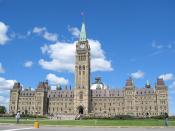The Structure of the Canadian Government
Canada's "Fathers of Confederation" adopted a federal form of government in 1867. A federal state is one that brings together a number of different political communities under a common government for common purposes and separate regional governments for the particular needs of each region.
In Canada, the responsibilities of the federal system include national defense, interprovincial and international trade and commerce, the banking and monetary system, criminal law, and fisheries. The courts have also awarded to the federal Parliament such powers as aeronautics, shipping, railways, telecommunications, and atomic energy.
The provincial legislatures are responsible for such matters as education, property and civil rights, the administration of justice, the hospital system, natural resources within their borders, social security, health and municipal institutions. The federal Parliament and the provincial legislatures share some responsibilities.
The roots of Canada's parliamentary system lie in Britain. In keeping with traditions handed down by the British Parliament, the Canadian Parliament is composed of the Queen (who is represented in Canada by the Governor General), the Senate and the House of Commons.
The Senate, also called the Upper House, is patterned after the British House of Lords. Its 105 members are appointed, not elected, and are divided essentially among Canada's four main regions of Ontario, Quebec, the West and the Atlantic Provinces. The Senate has the same powers as the House of Commons, with a few exceptions.
The House of Commons is the major law-making body. It currently has 301 members, one from each of the 301 constituencies or electoral districts. The Canadian Constitution requires the election of a new House of Commons at least every five years. As in the United Kingdom and the United States, in Canada voters elect a single member for their electoral constituency, in one round of...


